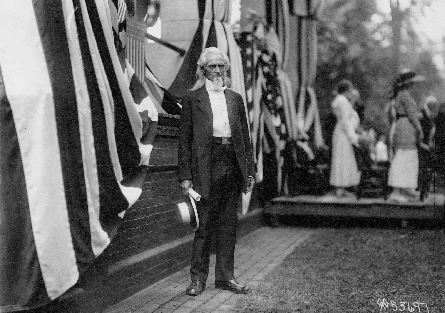In the spring of 1868 John Logan, Commander-In-Chief of the Grand Army of the Republic (GAR), a Union veterans organization, designated May 30th as a memorial day “for the purpose of strewing with flowers or otherwise decorating the graves of comrades who died in defense of their country during the late rebellion, and whose bodies now lie in almost every city, village, and hamlet churchyard in the land.”
The first national celebration of the holiday was held at Arlington National Cemetery on May 30, 1868. Approximately 5,000 people gathered around the veranda at Arlington Mansion, and after listening to speeches the visitors, including children from the Soldiers’ and Sailors’ Orphans Home, walked through the cemetery placing flowers on the graves of Union and Confederate soldiers.
Although the gathering at Arlington Cemetery may have been the first formal recognition of Memorial Day, records show that southern women already had adopted the practice of decorating the graves of war dead by 1865. In April 1866, the women’s memorial association in Columbus, Mississippi, decorated the graves of Union and Confederate soldiers there. After learning of their tribute, Horace Greeley, publisher of the New York Tribune, printed an editorial praising the event, and soon the practice of placing flowers on soldiers’ graves became popular throughout the recently reunited nation. Other towns, notably Waterloo, New York, and Boalsburg, Pennsylvania, also lay claim to being the first to celebrate Memorial Day; in fact Boalsburg bases its claim on an October 1864 observance.

It is little wonder that George Campbell, a resident of the U.S. Soldiers' Home
in Washington, D.C., was known to his comrades as "Uncle Sam"
Memorial Day observances have undergone many changes over the years. Initially May 30 was known as Decoration Day and recognition was limited to those who died during the Civil War. By the end of the 19th century, the name had changed to Memorial Day, and ceremonies marking the solemn event were held across the country. After World War I, Memorial Day was expanded to honor all those who had died in America's wars. Finally, in 1971 the federal government changed the observance from May 30 to the last Monday in May to create a three-day weekend.

On May 30, 1918, Memorial Day services in Washington, D.C., culminated with casting flowers
into the Potomac River in memory of those who perished on the Lusitania.

Three veterans at a Memorial Day ceremony. (L to R) John Finn served in the Civil War;
John Raeulin was a veteran of the Spanish-American War; and William Giering fought in World War I.
* * *
May 2002